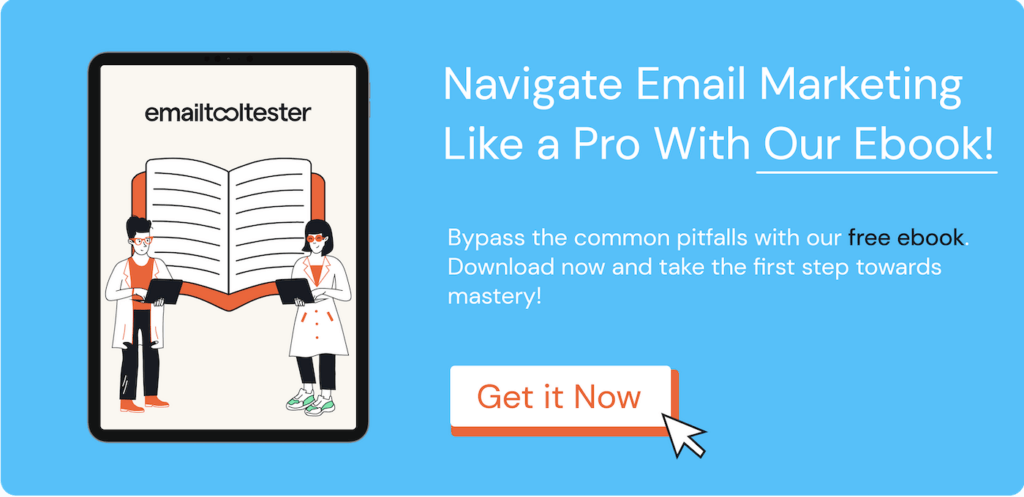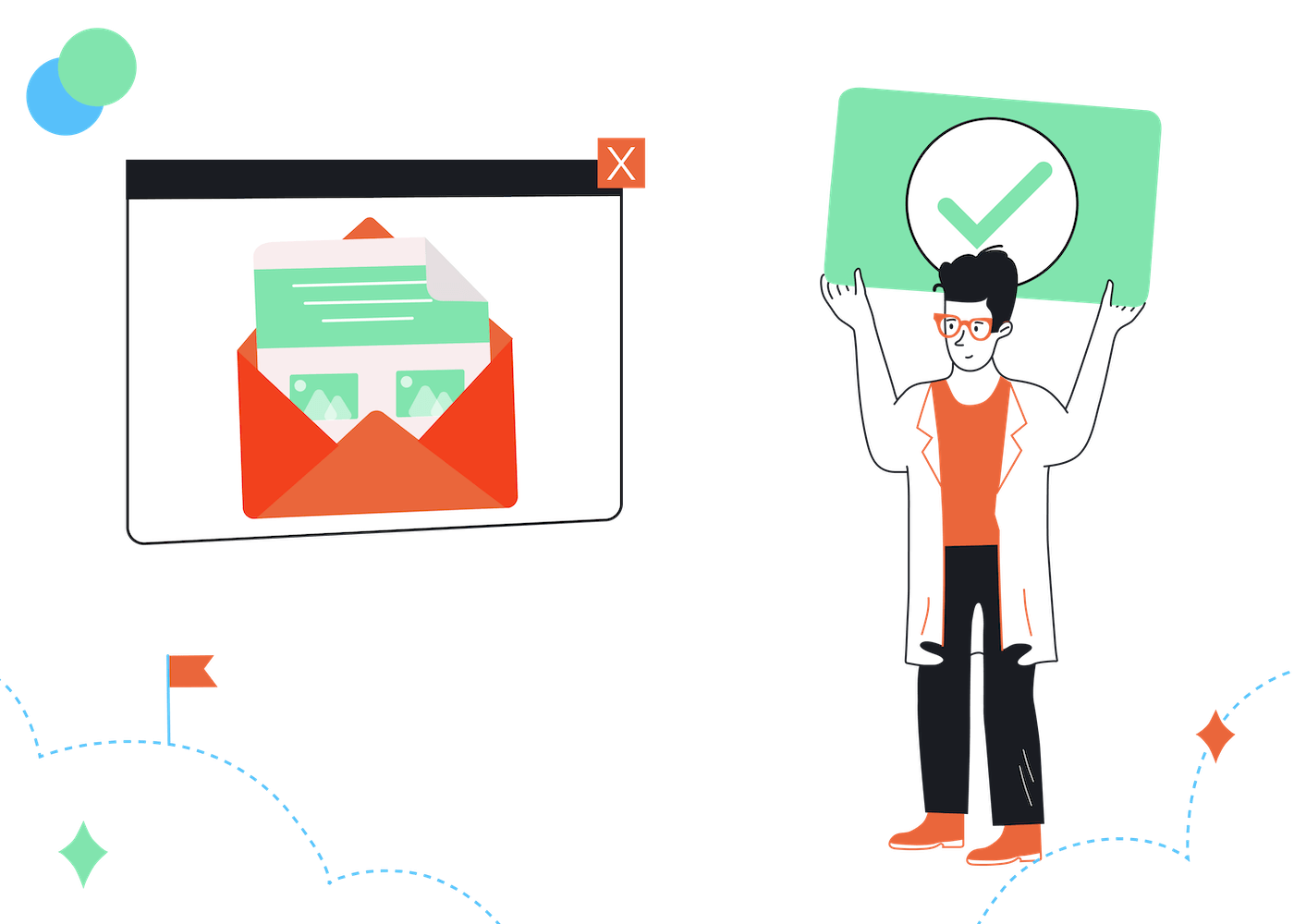Double opt-in might seem like a straightforward email marketing concept. But wow, the discussions about it are intense.
On LinkedIn, for example, we’ve seen marketers boldly assert:
- “Double opt-ins are a huge waste of time (and money).” (source)
- “Only have it on if it's required by a law to have it on—otherwise, it should be off.” (source)
- “If your customers won’t take an extra step [of clicking your double opt-in email’s link], they’re not worth the click.” (source)
And below their posts, there are dozens of comments from people agreeing (or disagreeing) with them.
So, do you need to use double opt-in? Is it required, especially from a legal point of view?
Here’s my take:
While double opt-in generally isn’t a legal requirement, I’d still recommend using it as it helps ensure you keep a clean list of quality subscribers.
More details below, but first things first. Let’s make sure we’re on the same page as to what double opt-in is:
What Is Double Opt-In?
Double opt-in is a process that gets users to confirm their email address after they submit it via an email form or landing page (which is the first opt-in). They’ll do this by clicking a link in a confirmation email (which is the second, or double, opt-in).
Need an example? Here’s our double opt-in email when you join our newsletter:
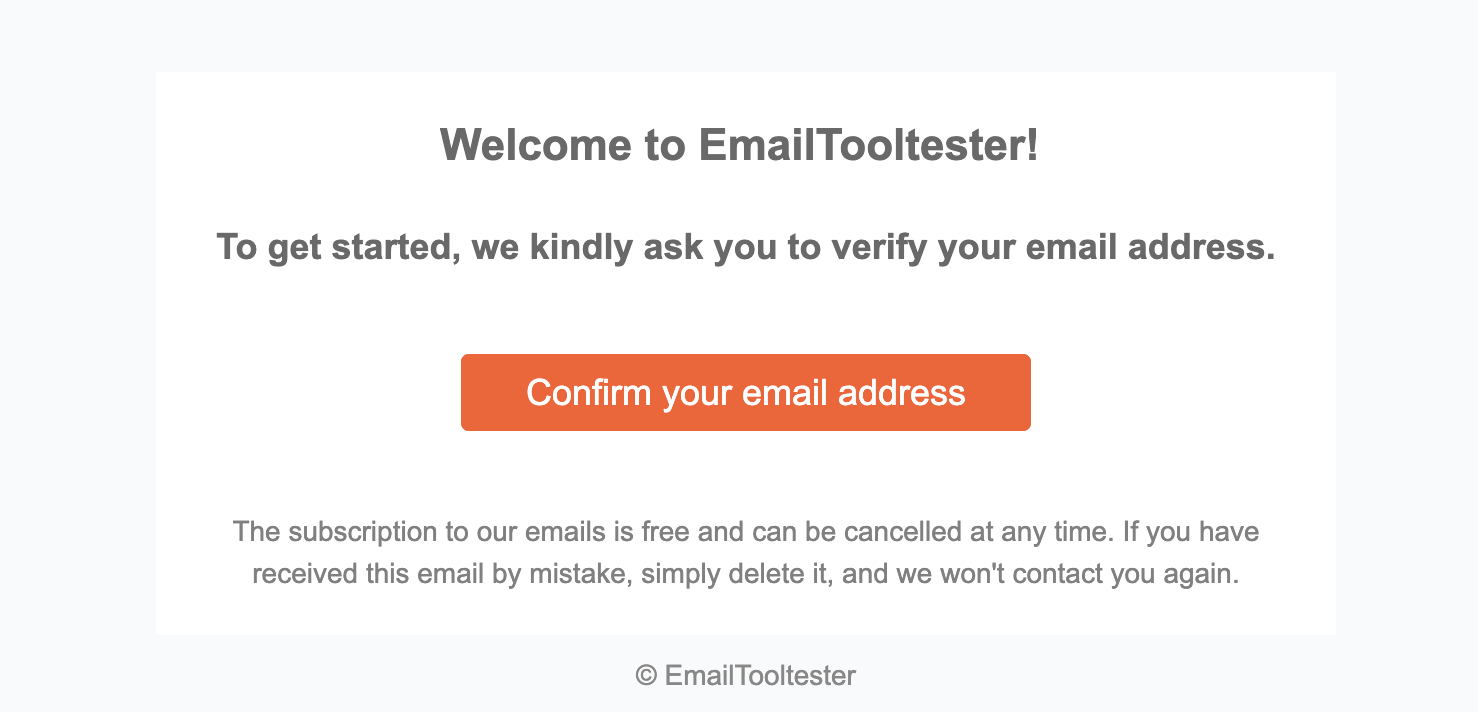
When users click a double opt-in email’s confirmation link, they confirm that:
- The email address they provided works. ✅
- They can access that email address’s inbox. ✅
Double opt-in can also be used to confirm the user’s consent to receive marketing emails — which is super important if you’re legally required to get this consent (more on that in a minute).
To set up your double opt-in emails to get email marketing consent, they need to tell users that clicking the confirmation link = agreeing to receive your emails.
Just like this double opt-in email from Gartner, which says: “By clicking on the ‘Verify my email address’ button, you are signing up to receive information about Gartner products and services.”

What happens if the email doesn’t make clear that clicking the confirmation link indicates the user’s consent to receive marketing emails?
In this case, users may end up confirming their email address — because they want to receive your lead magnet, for example — without providing this consent. You might then fall afoul of your country’s laws if you’re legally required to get email marketing consent but hadn’t done this before sending marketing emails.
Is Double Opt-In Required?
Are you legally required to use double opt-in? The answer is: generally, no.
For instance, if you check the General Data Protection Regulation (GDPR), which is the European Union’s data privacy law, it doesn’t actually say “You must use double opt-in.”
Likewise for the CAN-SPAM Act, which covers email marketing laws in the United States.
That said:
- Double opt-in IS a legal requirement in some countries. For example, Germany requires German businesses to use double opt-in to get email marketing consent.
- Double opt-in is also a best practice in countries like Switzerland, Greece, and Norway for getting the same consent.
So, if you’re unsure, consult a lawyer familiar with your country’s laws to confirm (pun not intended) if you need to use double opt-in.
Similarly, while email service providers encourage using double opt-in — and some even enable it by default — their terms of service generally don’t require users to use it.
Single Opt-In Vs Double Opt-In: Which Should You Use?
If using double opt-in generally isn’t required, should you anyway? Let’s look at some pros and cons. (Spoiler alert: there are mostly pros.)
Pro #1: Double opt-in improves your deliverability
Deliverability is a measure of how likely your emails are to reach your subscribers’ inboxes.
When users (1) open your double opt-in email and (2) click its confirmation link, email clients see these actions as positive feedback that users value your emails.
As a result, your deliverability will improve, and email clients will be less likely to send your emails to your recipients’ spam folders.
Pro #2: Double opt-in helps you collect working email addresses
If the user misspells their email address, they won’t receive your double opt-in email for confirming their email address. So, they’ll need to provide the correct email address to join your list.
(That said, email addresses can go bad over time. Scrub your list regularly to clean out addresses that no longer work!)
Pro #3: Double opt-in attracts higher-quality subscribers
Users who take the trouble to click your double opt-in email’s confirmation link are more likely to be interested in your email content. And they’ll show it by opening and clicking your emails more.
According to GetResponse, for instance:
- The average open rate for double-opted-in subscribers is 35.72%, versus 27.36% for single-opted-in subscribers.
- The average click rate for double-opted-in subscribers is 4.19%, versus 2.36% for single-opted-in subscribers.
With your fans loving your emails, you might have an easier time converting them into customers.
Pro #4: Double opt-in reduces fake signups
Fake signups happen when bots or humans with bad intentions enter (real/fake) email addresses into subscription forms without the email address owner’s consent. They can wreck your email engagement rates because they don’t open or click your emails after that.
Your deliverability can take a hit, too, if the emails bounce, or if the actual email address owner makes a spam complaint because they hadn’t subscribed to your list.
Fortunately, these bad actors generally can’t access the inboxes of email addresses they submit to forms. This means they can’t click confirmation links. Only the email address owner can.
So, if your double opt-in email’s confirmation link gets clicked, you can feel more assured that the subscriber is a real person who genuinely wants your emails. They’re not a fake signup.
(This isn’t guaranteed, though. I was once hit by a listbombing attack where the bots could click my double opt-in emails’ confirmation links.)
The main con: Double opt-in slows your list growth
Using double opt-in adds friction to the signup process because you make users jump through the extra hoop of clicking a confirmation link. If they forget to do this, you’ll have lost a subscriber.
According to GetResponse, for example, the average subscription rate for a double opt-in form is 0.33% compared to 1.28% for a single opt-in form. That’s almost 4X lower.
That said, having a smaller list is good if it means you’ve prevented all the fake signups or non-working email addresses from joining your list. You also improve your deliverability, among the other benefits I mentioned earlier.
So, as a whole, I recommend using double opt-in.
Possibly the only time I’d say skipping double opt-in is OK is if the user is your ecommerce store customer.
In this situation, you’ll typically have confirmed their email address during the checkout process. And you don’t need to confirm their email address again.
How to Implement Double Opt-In
If I’ve convinced you to use double opt-in, here’s how to set it up!
Most good email marketing services offer a double opt-in setting for their forms and landing pages, so it’s usually just a matter of finding and enabling it. Here’s how to do this in Brevo:
And here are the text instructions, if you prefer.
As you set up your email form in Brevo, you’ll see these confirmation email settings:
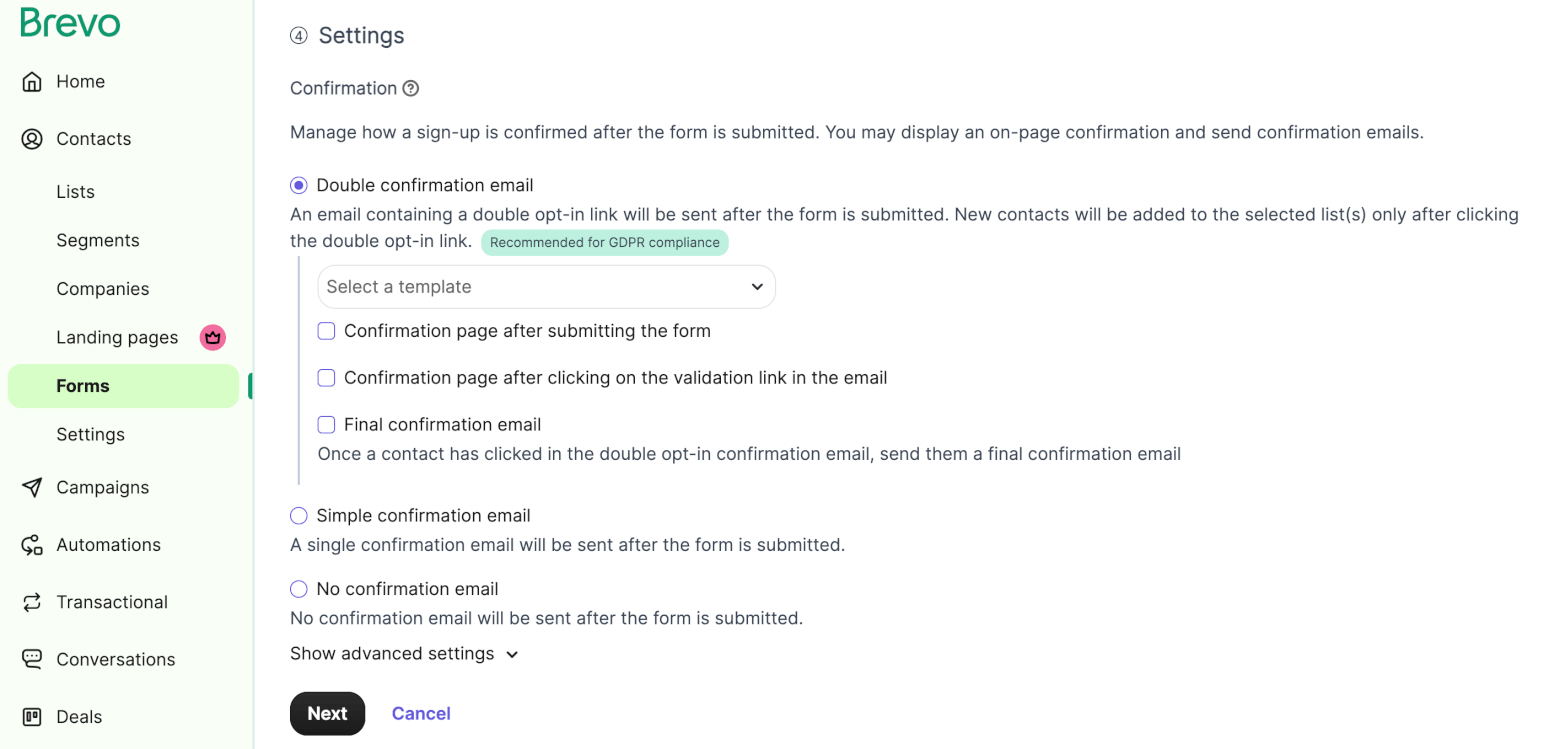
“Double confirmation email” is the double opt-in setting, and it’s enabled by default. Leave it enabled. Then, choose a template for your double opt-in email.
Click “Next” to continue with the form setup process. Then, navigate to your double opt-in email template and customize its contents.
When updating the email’s text and confirmation link text, make sure the email clearly communicates that clicking the link will confirm the user’s email address (or subscribe them to your email list, if you want to get email marketing consent).
You can even place the confirmation link text in a button to draw attention to it.
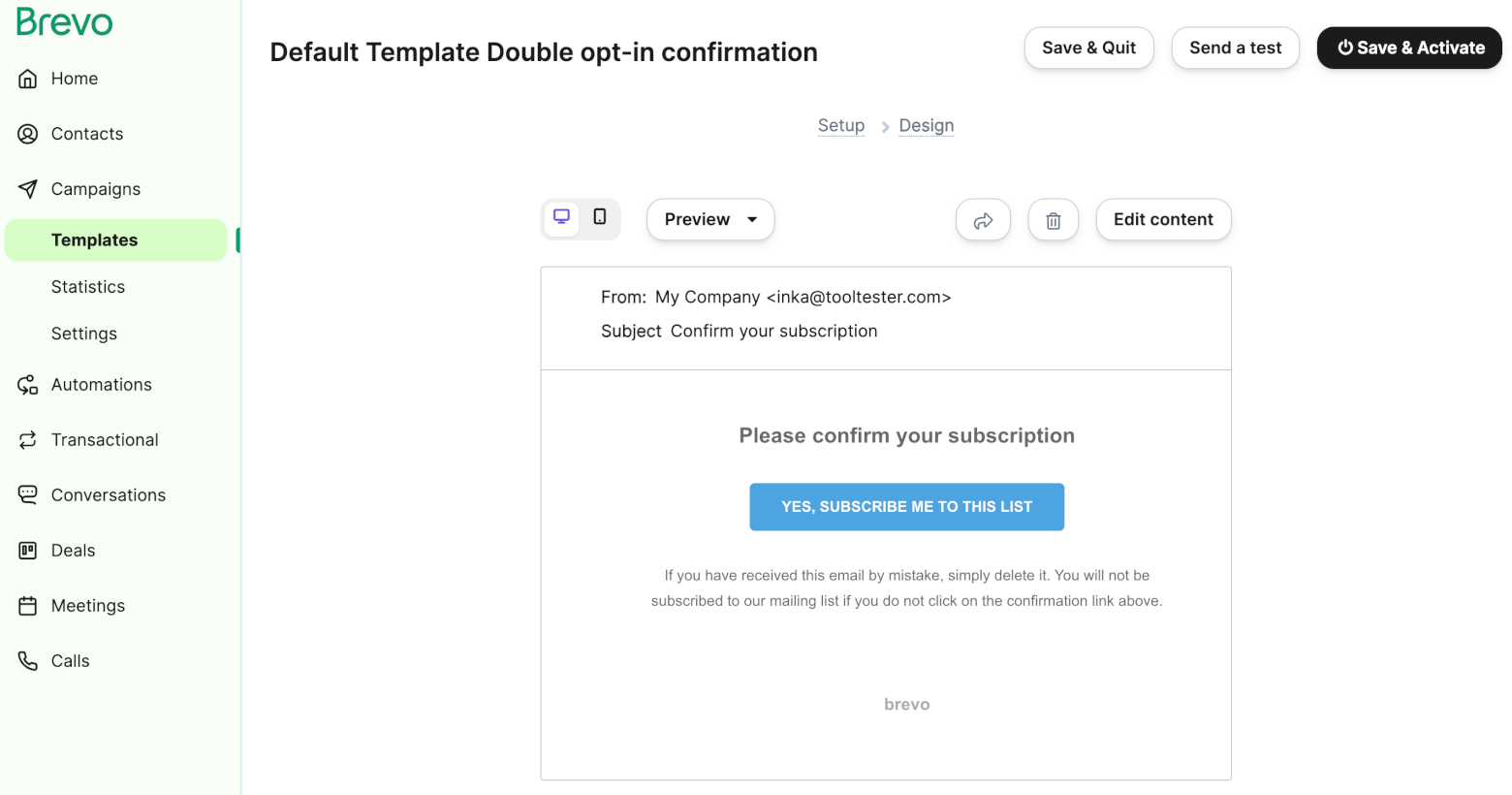
Conner Staples, Deliverability and Compliance Specialist at Kit, also recommends putting this text at the top of your double opt-in email, to help people easily opt out if they change their mind about getting your emails:
“You are receiving this email because you signed up for our list. If you don’t want to receive additional emails, please click here to unsubscribe.”
“[Including this text] is beneficial for preventing people from submitting your double opt-in email as spam,” Conner explains.
“Unsubscribes don’t negatively impact your deliverability, but one spam complaint can spoil the broth!”
Final Tip: Don’t Neglect Your Domain Reputation
Although using double opt-in generally isn’t required, there are way more pros to using it than not. In the long run, you keep your list healthy and help your emails reach your subscribers’ inboxes, too. So, I’d recommend using double opt-in if you aren’t already.
Then, to get the most from double opt-in as you grow your list, work on your domain reputation.
Domain reputation is a measure of the trustworthiness of the domain you use to send emails. If your domain reputation is low, email clients may be more likely to treat your emails as spam.
And you know what?
These emails include your double opt-in emails. When your double opt-in emails land in the spam folder, your recipients may be less likely to confirm their email addresses. If so, you can’t send them any more emails.
“If your domain reputation is suffering, so will your double opt-in emails,” advises Conner. “Make sure you maintain a strong domain reputation to avoid these emails ending up in spam!”
Learn more about domain reputation — and its sister concept, IP reputation — in our IP reputation guide.
Have questions about double opt-in? Drop them in the comments below, and we’ll reach out.
Our Methodology
This article has been written and researched following our EmailTooltester methodology.
Our Methodology
